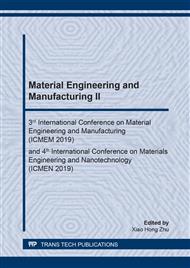p.3
p.9
p.15
p.25
p.31
p.38
p.42
p.50
Research on Microstructure and Hardness of Laser Cladding Using the Mixed Powder of Nano-TiC and Ni-Based Alloy
Abstract:
Aiming at the problem of poor high-temperature wear-resistance of rope clamp used in super-high speed elevators, the experiments of laser cladding to prepare carbide reinforced composite coating were made. nanoTiC powder, Ni-based alloy powder were used as cladding material. The microstructure and hardness of composite coating were tested by relevant equipments. The research results show that the composite coating is made up of TiC, Cr3C2, Fe3C and Fe-Ni-Cr-C HYPERLINK "javascript:void (0);" solid solution. When the content of TiC is 10%, 30%, the morphology of TiC is presented as dendrite-like and the morphology of HYPERLINK "javascript:void (0);" solid solution is presented as cellular-like. When the content of TiC is 50%, the morphology of TiC is presented as block-like, lath-like. There are some microcracks on grain boundaries. At the content of 30%, laser power 1.5KW, scanning speed 600mm/min, the laser cladding has no crack and hole. The average hardness of composite coating is 701HV0.2. Using this technology to the surface strengthening of elevator parts, the wear resistance and service life can be greatly improved.
Info:
Periodical:
Pages:
9-14
Citation:
Online since:
January 2020
Authors:
Keywords:
Price:
Сopyright:
© 2020 Trans Tech Publications Ltd. All Rights Reserved
Share:
Citation:


